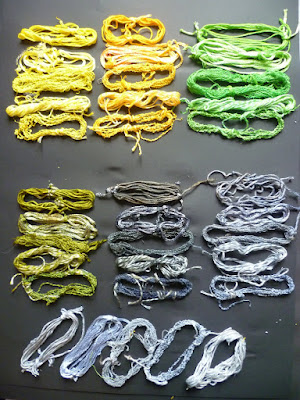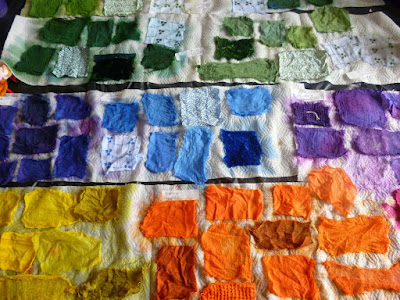After a long break, I've started on Diploma work again - and not before time!
I decided to use cold water 'fibre-reactive' dyes (Procion) for my samples, although I'll probably experiment with other methods too.
This first batch of samples was taken from an old gravestone, adorned with a dove. This is not the type of colour palette which I would normally work with - and that's why I chose it.
All of the portfolio pages are A2 size.
 1
1 2
2I liked the strong contrast between the three shades of grey and the 'acid bright' yellows and greens. I've used a range of fabrics, listed in the left hand column.
Fabric sample number 5, the cotton mix jacquard, looked different on each side. I've used the 'front' for some samples and the 'back' for others, to show the different effects.
 3
3Dark grey fabric sample 3, the silk chiffon, had disappeared when I came to sew the strips together. Of course, just after I glued the samples in, it re-appeared -jumbled up with the dyed threads. The silk chiffon was very wispy and elusive. I'll have to keep a watchful eye on it in future.
 4
4I put a selection of skeins into each plastic bag, as I was dyeing. They are (from top to bottom)
a) bamboo b) cotton boucle c) viscose ribbon d) viscose loop with cotton binder
e) cotton/polyester slub
 5
5Here they are, in all their glory.

6)
To use up the left over dyes. I put these pieces of velvet in a tray and dropped the colours onto them. I think the top piece is synthetic, as it came out very pale. They were cheap bundles (60p each) and had no details with them so I don't really know what they were made from.
Overall, I was pleased with this first batch of dyeing. The samples were very close to the gravestone colours so I feel quite encouraged by this.
Roll on the next set of samples. I may post them when I return from the gym, if I'm in a fit state!
 1
1 2
2 3
3 4
4 5
5












